Smoky Grey
‘Apocalyptic city’, I label Bhilwara, due to its industrial space and smoky air, desolate roads, always in grey, light yellow hues, is what I tour in. This is a western India town, my field area, talking to the migrant workers who left their homeland to earn a wage here. Riding past the factories, with a pungent smell that initially holds on chokehold, making you aware of your breathing, eventually becoming a normal sense of aroma that lingers around, becoming an accompany.
The buildings with high chimneys, and the sounds of the machines, the roads with humongous trucks with their written ‘thought of the day’, are my accomplices on this journey. They flow in a rhythmic pattern of dusty existence now, making the palette of grey-yellowish hues one that I’ve accepted. Also made friends with the familiarness that tags along.

Papery Blue And Cushiony Red
A change of frame, a change of palate comes in when back to the office. Like the transition of the black and white television set, but the colours are still hazy. With files and papers, and a laptop screen with MS-Word being open, currently where I’m jotting this down, a sense of blue and red presents itself. The feeling of being inside on a hot sunny day, rhythmic fan buzzing while printers sing from the office room.
The constant ravaging through drawers for pens, the writing on the notepads, the calls with thekedaars on money issues with labourers, and the water dripping out in the sewage, all come together in an office room.

Sunset Yellow
Leaving office to finally set foot for the journey back to the room, involves pit stops that bring in their vibrant hues to the palette. With the setting sun, comes a heave of sigh, a space forming for the mellowed down space, away from the industries, away from the office, away from the sense of mundanity, away from the sense of finding purpose.
This mellowness brings in pit stops. First, the main road pani-puri seller. In his last year of college that he funds through this stall, and stays almost every day from 2pm to 8pm, offering 6 different paani’s for the aloo puri. One of pudina (mint), hajma (asafetida), khajur (dates), lasun (garlic), jeera (cumin), and imli (tamarind). Once tasted all the 6, it feels like that scene from Ratatouille, where Remy (Rat, the main character) with his eyes closed, has multiple fireworks going on his head. The smell, the taste, all formulating into the vibrancy of a feeling. This was one of those experiences, spreading like the sunset rays, bringing in the setting feeling.
When asked,
“Itne saare flavours banana kahaan se sikha aapne, aisa main pehli baar khaa rahi hoon” (I’ve not tasted so many different flavours, where did you learn this from?)
He beamed, “Mera bhai kaam karta hain Mumbai main, udhar aise hi banate hain, who dekhke aaye toh banana lage udhar, toh maine bhi seekh liya unse”, (my brother works in Mumbai, selling paani puri, there this is quite common, he had learned from there and started making, so I also eventually learned from him). The gig economy is transferring skill sets one learns from their work areas, blending in cross-cultural work. 20 rupees for these puri’s makes it all worth it.
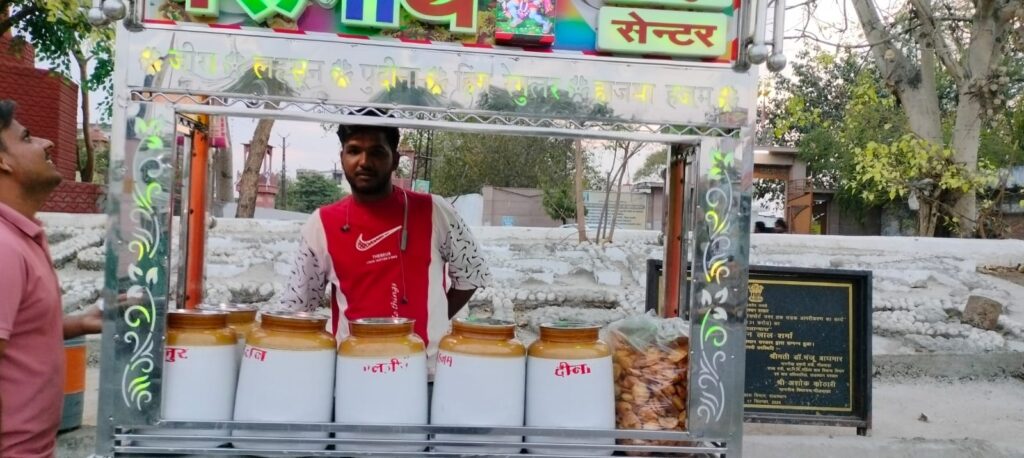
Blue
Walking back from a flavourful session, I head towards my house lane. Before I stumbled upon this flavored pani-puri stall, my go-to was the MP uncle. His bright blue stall on wheels, I kept an eye out for from a distance. He maintains he leaves only at 8pm, but to my disappointment, often I do not find him even at 7pm when walking back from the office.
This day, however, his brighter blue stall was shining even brighter with the setting sunrays making a perfect golden hour picture of him and his stall. Seeing this, I also could not resist myself. MP uncle has settled here ever since he was 14, migrated when his uncle used to work in the factories. After a few years, his uncle started a business, that still runs in the Bhilwara market, whereas he runs this one beside the residential area.
An exchange of beaming smiles, and eye contact, acknowledging each other presence, like two strangers giving each other a nod. He hands me over a paper bowl, and I start my ratatouille brain firework session again.
I had asked him how he had celebrated Holi, to which he said,
“Hum 21 ko manaenge, Prabhu dev ka poojan karke phir. rabhu dev ki kahaani toh pata hogi aapko.”
“Bohot lambi kahani hain, lekin short main batatau hoon.”
Holika Dahan
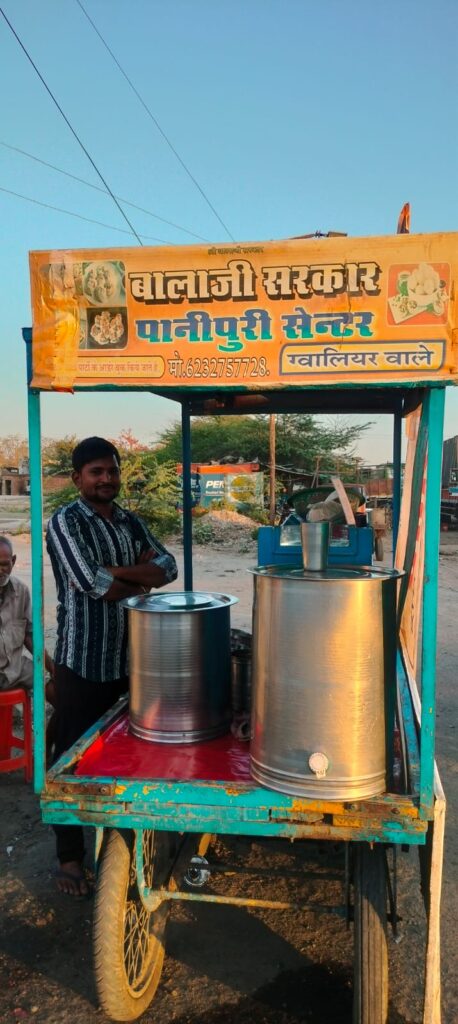
“Raja Hiranyakashipu, chahta that sab ussi hi ko puje, Bhagwan Vishnu ke jagah. Uska beta, Prahlad, Vishnu ke ho pujte the, jisse raja ko gussa aa gaya. Hiranyakashipu koshish karta ki Prahlad ko maare, lekin kisi divya maddat ke sahaare woh har baar bach jata. Ek din, raja ki behen, Holika, jiske paas fire proof shakti thi, woh baithi prahlad ke saath agni main, lekin uski shakti nahi chali, aur who khud jal gayi, aur prahlad zinda wapas aaya; aur iseko holika dahaan ke jariye manaya jaata hain.”
(King Hiranyakashipu, wanted everyone to worship him instead of Lord Vishnu. His son, Prahlad, remained devoted to Vishnu, which angered the king. Hiranyakashipu tried to kill Prahlad multiple times, but divine intervention saved him always. Finally, his sister Holika, who had a fireproof boon, sat with Prahlad in a fire. However, her boon failed, and she was burned, while Prahlad remained unharmed. This event symbolizes the victory of good over evil and is celebrated as Holika Dahan.)
Then he says,
“Sanatan dharma bohot khubsarat cheez hain, ek bar padh ke aur Anubhav karke dekho” (Sanatana dharma is a beautiful thing, your should read and experience it once).
I pay, exchange words of thanks for the 10 rupees for 5 puri plus a story session, and head out to my next stop.
Mustard Hot Yellow
After the MP style pani-puri, I thought of taking some omelettes for my home, and having a cup of chai. This was the first chai uncle I had spoken to after finding a room in Bhilwara. He played a multipurpose role in terms of being a provider for an outsider like me. Chai, omelettes, bhurji (scrambled eggs, spiced up with Indian condiments). This eventually graduated to puri and sabzi that again eventually graduated to secretly selling chicken, fish, and mutton curries upon request (part of the business that he ran to selective customers, only on the night), and ultimately graduating to pohas (a breakfast item made of beaten rice) in the morning.
This steady rise in business activity took time, his progression to the new menus to his stall came about with time. His family had come from Punjab, migrating to Bhilwara Rajasthan, where his father used to work in the industries. After settling here for years, he started narrating his story over a cup of tea.
“Asal main hum Pakistan se hain, mere par Dada partition ke pehle Punjab chale gaye the. Phir tab bohot hinsa chal rahi thi, toh laakhon lok Punjab se desh ke dusre jagahon pe nikal pade. Kuch Indore, kuch Rajasthan, kuch Kahin aur. Hum aa gaye Rajasthan, aur bas, tabse yahin hain ghar apna.”
(Actually we were in Pakistan before partition. After the separation, my great grandfather had moved to Punjab. However, due to violence and wars during these years, lakhs of Punjabis had migrated to different parts of India, a few to Indore, a few to Rajasthan, few somewhere else. We came here, Bhilwara, and have been here ever since. We own our land now, this is only our home).
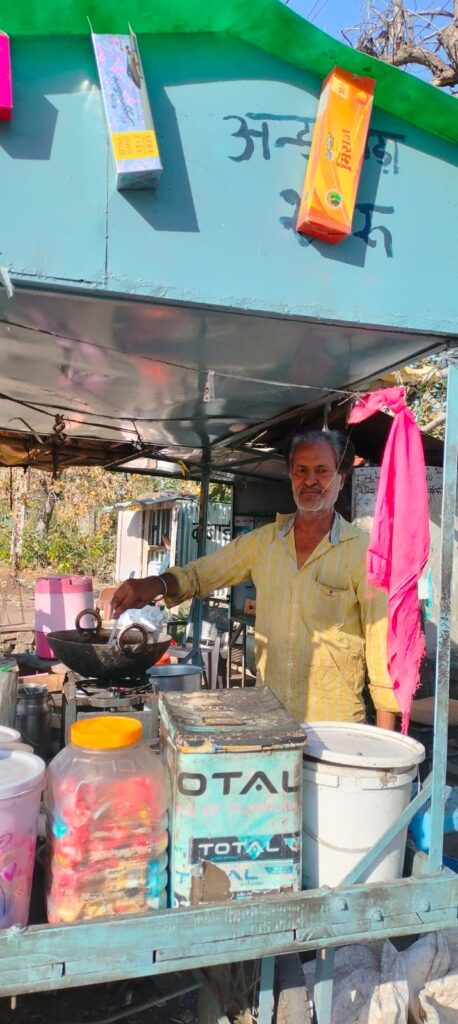
Goodbye
The first day I bought chai and omelette from him, I held with me the feelings of newness, a sense of fear, and unsettlement. But now, the last few days that I am here, colours feel brighter, the weird amalgamation of settled and unsettled feeling, comfort and discomfort both tugging at each other. Leaving feels easier, but to not see my regular providers, my usual storytellers, feels a little incomplete. It’s almost like the process of painting this picture is over, and now, finally, I can appreciate the picture.

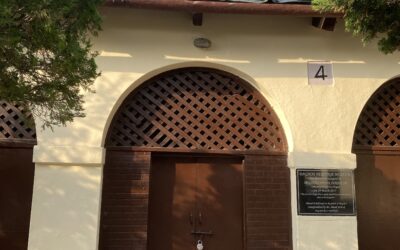
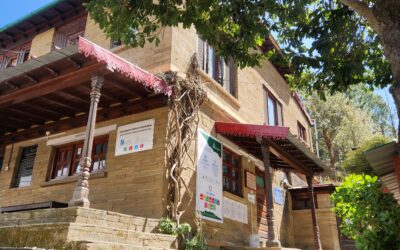
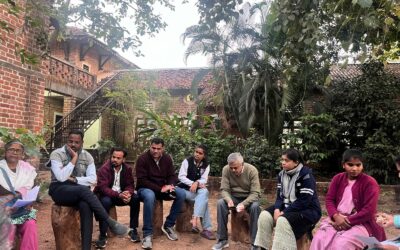
0 Comments